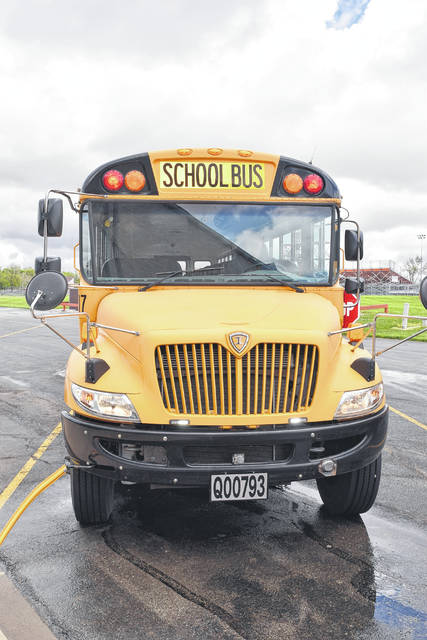
NEW PARIS — National Trail Local School District has been working to increase awareness of buses on the streets, in hopes to decrease stop arm violations and other bus-related traffic violations.
According to Ohio School Boards Association (OSBA), school bus passing violations are at an all-time high nationwide. These have resulted in student fatalities and are the cause of significant concern among school transportation professionals and parents.
Many of Ohio’s districts participated in a survey recently to record the number of violations on a single day to help quantify the problem. Here are the results of that survey:
•4,157 drivers responded, reporting a total of 1,521 violations.
•693 violations occurred during morning routes.
•45 violations occurred during midday routes.
•783 violations occurred during afternoon routes.
•1,107 vehicles passed the school bus from the front.
•414 vehicles passed from the school bus from the rear.
•1,490 vehicles passed on the left side of the bus.
•31 vehicles passed on the right side of the bus.
According to National Trail Transportation and Safety Director John Toschlog, being on the ground waiting at the bus stop is the most dangerous time for a child. Once they get onto the bus, the vehicle is constructed to be safe inside, but the driver does not have any control over what decisions that child makes while on the ground.
This is why training is the most important aspect of bus safety.
The bus driver must train the student on when to cross the street and what to look for, to ensure their safety. The student cannot cross the street until they’ve received the proper signal to do so.
The training of bus drivers is equally important. Drivers are required a minimum of 15 hours of training before they get their license, but on average National Trail Drivers turn in 25 hours of training before they get their certificate. The district then places the new drivers with experience drivers to get more training hours in.
Stop arm cameras is a new attempt to cut down on violations. Often times, violations go unreported because the bus driver is more concerned with the safety of the student then writing down a license plate number of a violator. Stop arm cameras will turn on as soon as the stop arm is engaged. They are designed at a higher resolution to catch license plate.
National Trail does have one bus with a stop arm camera, although it is not yet in service.
According to Toschlog, the focus that National Trail School District is taking now is trying to make their buses more visible to drivers. They have installed an auxiliary warning light system that seems to be making a big difference towards visibility of buses.
The lights are bumper height on the school bus and strobe red and white or amber and red, depending on the year the lights were outfitted. Regardless of the color, the lights will be effective as they will be strobing LED lights. The overhead lights can also be in a strobing pattern, but must match the auxiliary warning lights.
All but two of the current route buses have auxiliary warning lights on them and it is in the districts plan to outfit the last two with those lights.
Toschlog gave the following advice for people who are on the road with a school bus.
“First of all, be patient if school buses are in the area. Just slow down and take your time when you see a school bus approaching or in the same vicinity that you’re traveling. When you see the yellow lights, that indicates that a bus is about to make a stop. The law does not require you to stop at yellow lights, but it does indicate that bus is preparing to stop and you need to be stopped by time the red warning lights come on,” he said.
“Typically, when the door opens that activates the red light system. At that point, all traffic has to stop. I know there is a lot of confusion about four way and highways. Traffic that is in the same direction in both lanes of a highway has to stop when a bus stops. On a four lane, the two lanes on oncoming traffic does not have to stop, but the two lanes you’re on does have to stop. Of course, on two lane roads, both lanes of traffic has to stop.
“You have to stop a minimum of 10 feet in front of the bus and 10 feet behind the bus. That is the minimum amount, it is recommended that you stop farther away. Bus drivers are trained not to signal for those students to cross the road until they are sure that traffic has stopped. A lot of people start slowing down half a mile away and approach at five miles an hour, but bus drivers are trained not to cross those students until all traffic has come to a stop.
“Just give them more room. Know that buses turn a little bit wider. If a car is pulled all the way out to the intersection so they can see, that bus may slow down or stop to wait till they come out, because the bus cannot make the turn if a car is pulled all the way out. Just be aware that the school bus is a large vehicle that does require some space to make turns.
“All school buses, regardless if they have students or not, must stop at railroad crossings. They will be stopping 15 to 50 feet, so prepare to stop if you are following a bus and it comes up to a railroad crossing.”


